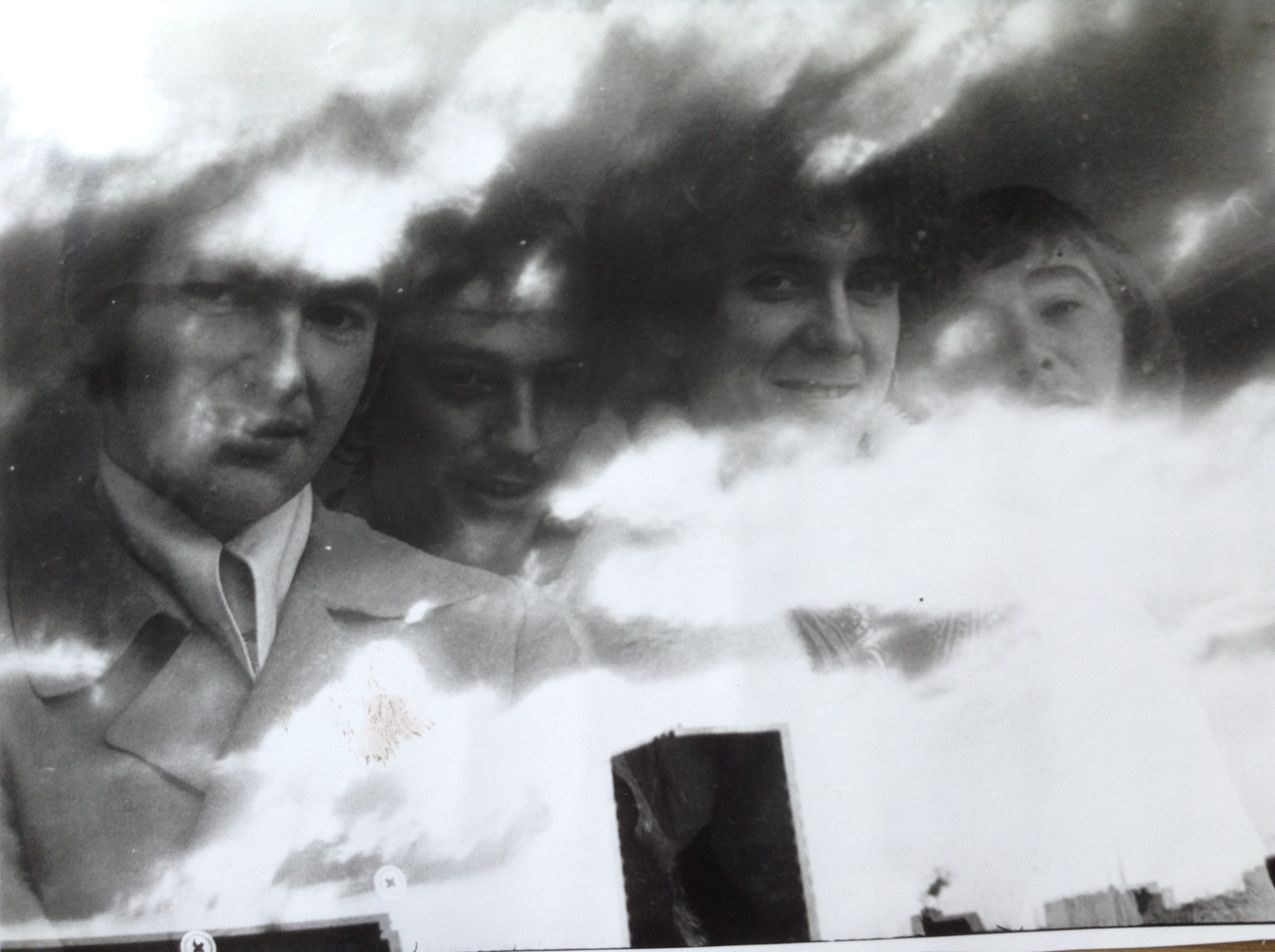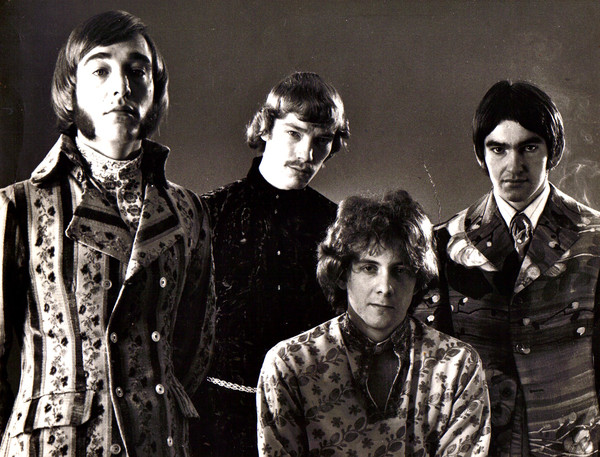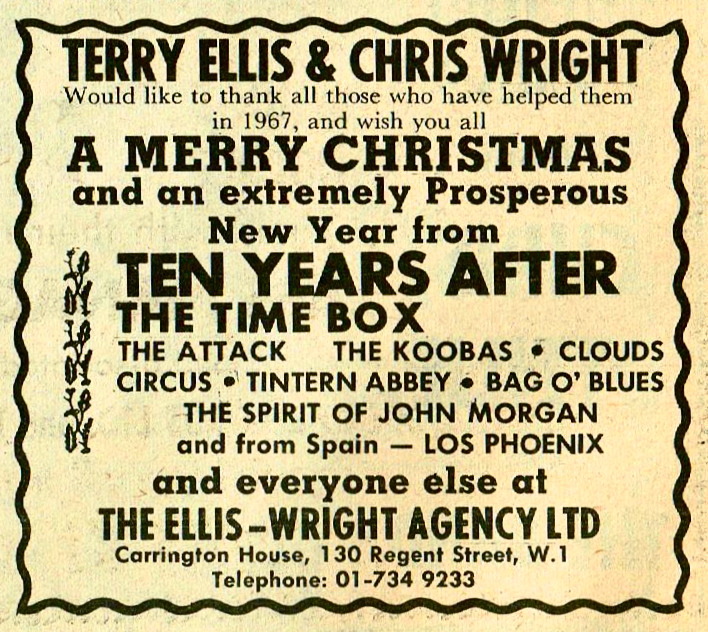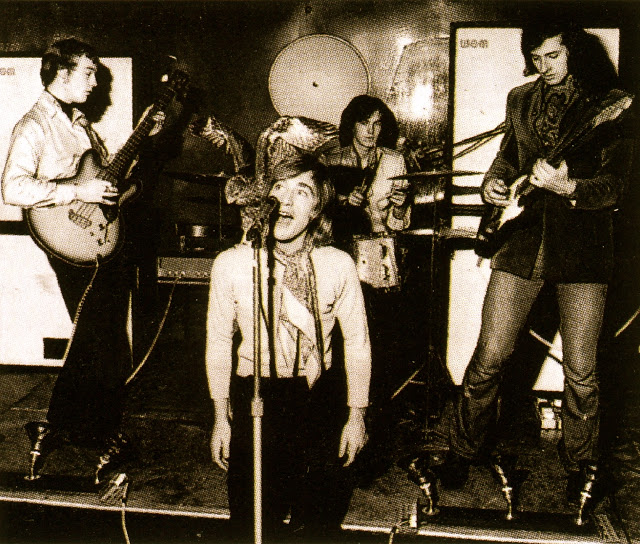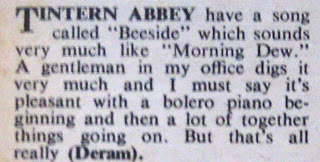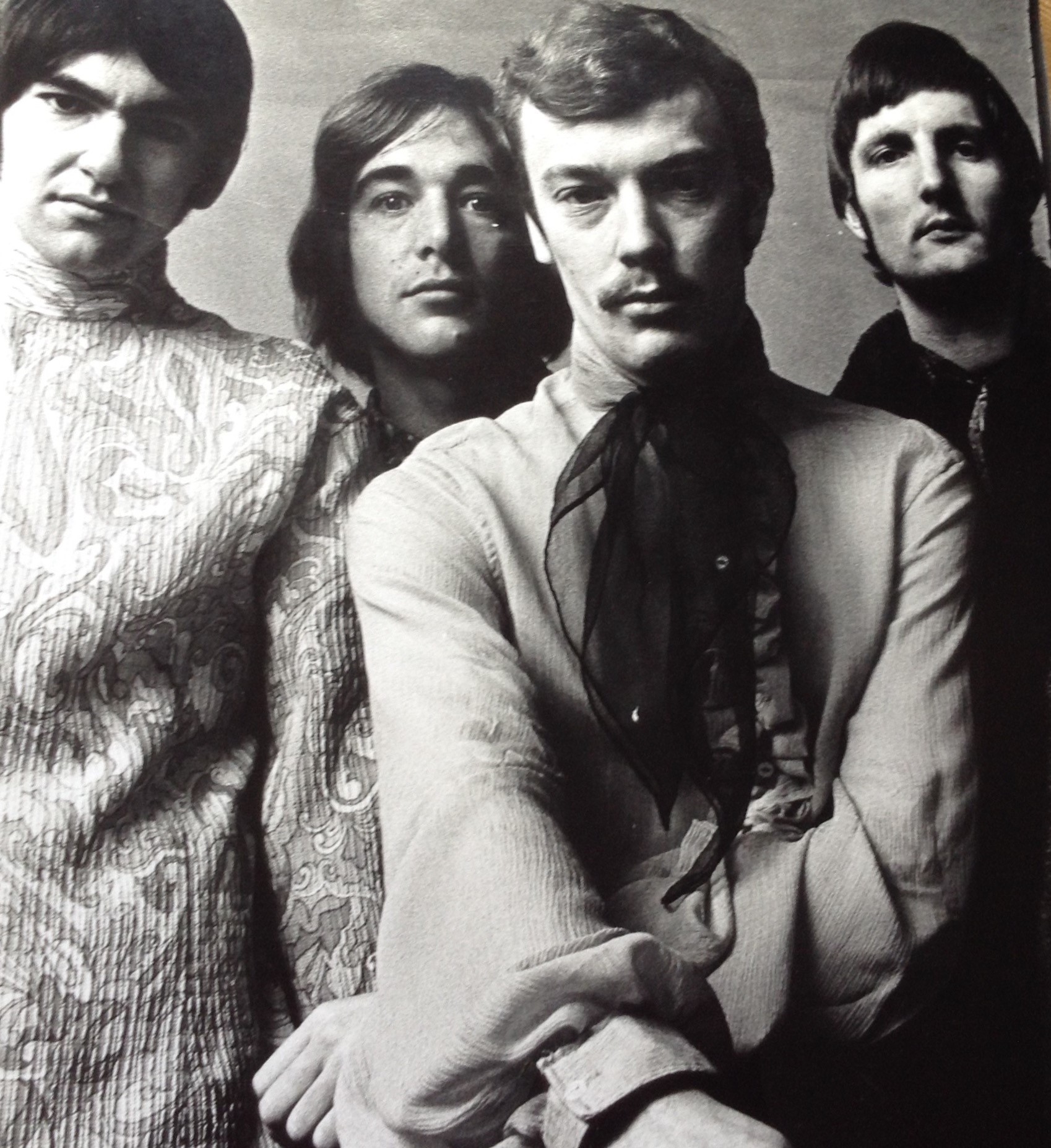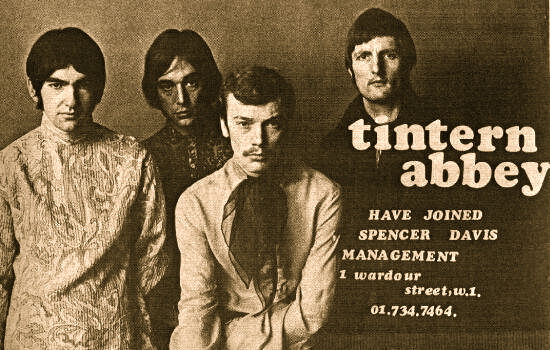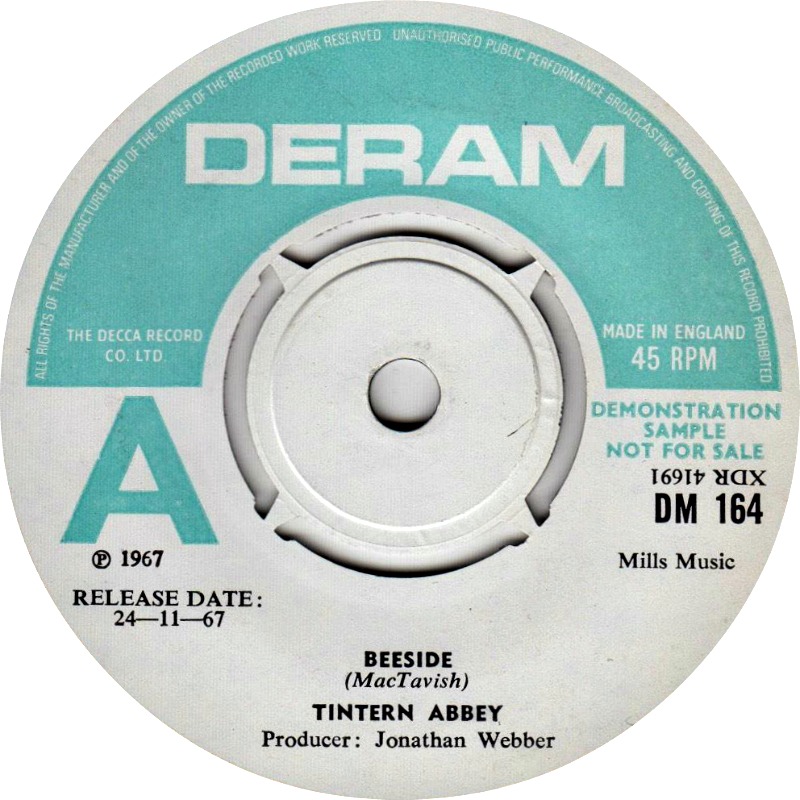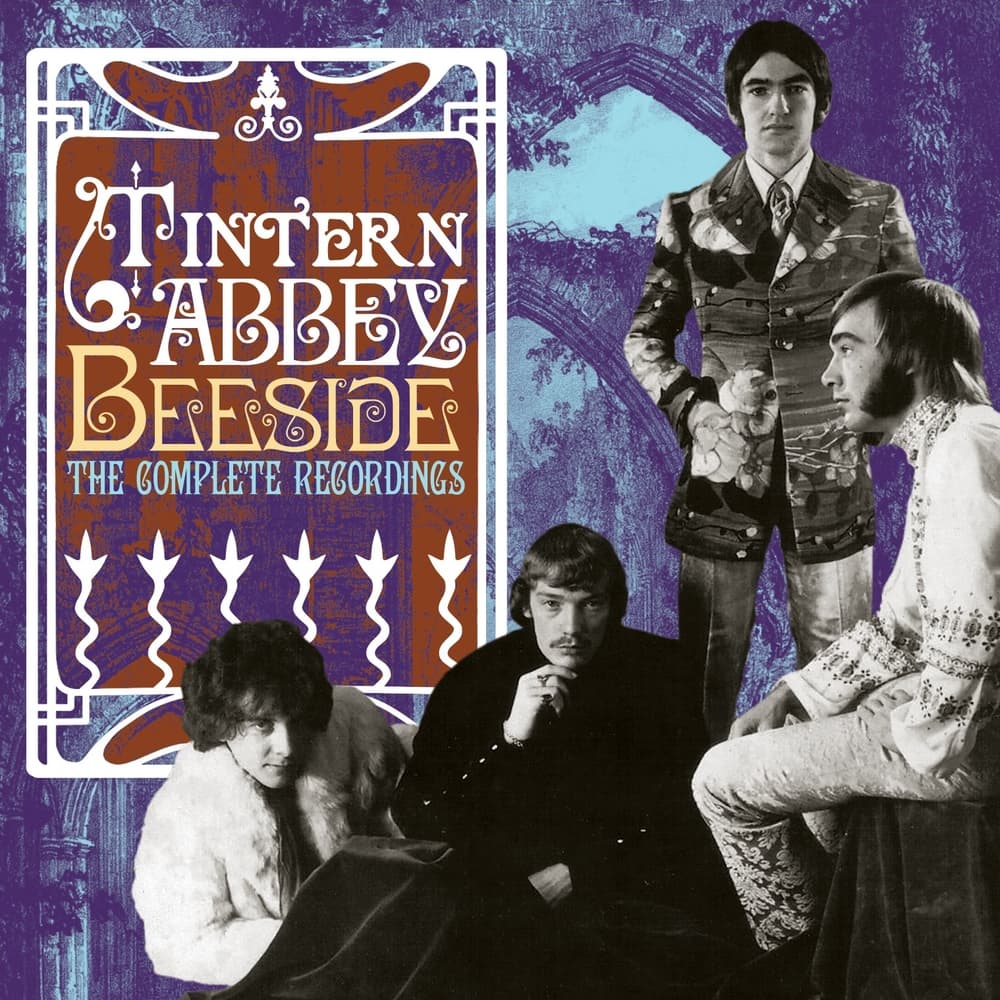Tintern Abbey’s ‘Beeside: The Complete Recordings’ is the most important collection of unreleased British psychedelic music for many years. Bassist Stuart Mackay speaks to Jason Barnard about the group’s history and shows why this new set further enhances the high reputation already established by November 1967’s legendary single, Beeside / Vacuum Cleaner.
Tintern Abbey: first line up on roof garden of Nigel’s penthouse flat
Where are you originally from and how did you get into playing music?
I was born in Pateley Bridge, North Yorkshire in 1946 and moved to Harrogate prior to attending Primary School. My father was an automobile engineer (family firm of Mackays of Harrogate) and had an acoustic guitar which he struggled to play. I was fascinated by this and by my early teens I bought a basic electric guitar and teamed up with like-minded friends to form the imaginatively named group, “The Strangers” who specialised in Shadows numbers.
What were your first groups and what was the music scene like?
I played lead guitar in “The Strangers” and our gigs were mainly schools and local youth clubs. Subsequently I changed to playing bass and joined a local rhythm and blues group who re-branded from ‘Us4” to become, “The Sect” and steadily built up a large fan base on the local circuit. Our repertoire was mainly Rolling Stones, Small Faces, Yardbirds etc., although we were starting to write and play our own material.
Other local groups at the time included The Vikings, The Kokomos, Barry Corbett and The Mustangs and the Leeds based group, The Outer Limits. Invariably they were playing cover versions of current pop music whilst we were starting to develop our own style and material.
The range of our gigs expanded to take in universities and the East Coast and down to Manchester and we were approached at the Tahiti Club in Huddersfield by Canadian, Steve Hammond who was on a mission to recruit a backing band for his debut single – a cover version of the Tommy James and Shondells number, “I Think We’re Alone Now” (ironically many years later this did become a number 1 hit for Tiffany). Steve accommodated the band at his flat in London when we moved down there and turned professional. His flat was in the house of Zoot Money on Gunterstone Road in West Kensington – referred to in the Jimi Hendrix biography and frequented by many musicians including Eric Burdon, Van Morrison, Eric Clapton, Marsha Hunt, Alan Price and of course Jimi himself.
The single failed to have any success and the group disbanded although I stayed on with Steve Hammond as we connected well with each other and were already writing material together.
How did you meet David MacTavish?
My first meeting with David took place at the Fulham Job Centre during my first and only visit to that emporium having been urged to go and ‘sign on’ by Steve due to the absence of any regular income at the time! Standing in the queue I found myself next to a colourful character who was amusing everyone with his banter and soon struck up a conversation with me on discovering that we were both unemployed musicians.
How was Tintern Abbey formed and what was the first line-up?
Discovering that I played bass and that I had all my own equipment David immediately invited me to go to his flat at the Worlds End part of Kings Road where he and Don Smith were forming the basis of a group. Don recruited John Dalton as drummer and the four of us immediately hit it off together and were able to communicate musically in an exciting way.
Why did the group choose the name Tintern Abbey?
As the group started to gel more and more together discussions took place as to a suitable name for the band and David and I both expressed a liking for the poems of William Wordsworth amongst which was ‘Tintern Abbey’. The philosophy of the poet and the poem being that whilst time may pass by the beauty of nature remains unchanged and we all felt we could empathise with this and hence the name was formalised.
Did you have any memories of your first recordings?
Our first couple of demos were financed as I recall by another of David’s flatmates who worked in a bank and had little involvement in the music scene. He did however help us in producing the demos and then chose to move out of the flat as he was getting married. I took over his room and we then came into contact with Nigel Samuel, a young millionaire who amongst other things was financing the underground newspaper International Times. Nigel’s wife, Suzy was a great friend of a fashion designer called, Snookie who used to call round and see the group regularly and persuaded us to upgrade our stage outfits. Nigel loved the group and the music and financed all our subsequent recording sessions. I think we were on an elevated astral plain most of the time as the actual sessions are but a distant memory of head phones and an extension of our musical conversations.
Who managed Tintern Abbey and how did they help you?
This probably is the crux as to how Tintern Abbey did not make it into the main stream. Whilst our manager throughout was Nigel, I think it is true to say he had little experience or knowledge of the music scene. He provided us with a comfortable base in one of his properties on Pavilion Road, formerly the home of International Times Newspaper. He financed all our overheads, equipment, van and roadie and gave us a generous weekly retainer to enable us to concentrate on our music. He arranged our visit to Bodmin in Cornwall to stay in a cottage for a month and immerse ourselves in our music and to subsequently play in a club in Holland to become accustomed to audiences. For a period, we were signed to Spencer Davis Management but that did not produce many bookings.
Do you have any recollection of Tintern Abbey’s early gigs and what material did you play?
As with the early recording sessions most of our gigs were conducted on a elevated platform of consciousness with the group starting each set with David sitting alone on the stage with incense burning and Thor the buzzard perched on her stand beside the microphone. The drummer would presently immerge from the wings and start rolling out symbol crescendos, I would then appear and start playing an Indian style Raga rift on the bass and the guitarist would then join the ensemble and pick up on the rift I was playing until on a hidden signal we would all launch into a high-volume, high-energy version of ‘Vacuum Cleaner’ or ‘My House’ or ‘My Prayer’. One of our favourite gigs of course was at the Marquee Club in London where we played regularly supporting such bands as ‘The Nice, The Move and The Family’. We also played at the Electric Garden – an underground venue at Covent Garden where our experimental rotating strobe light apparatus went berserk and flew off into infinity. We also played regularly played at Blaises and the Speakeasy together with appearing on the university circuit where the audiences were becoming more accustomed to sitting down on the floor and listening to the music rather than dancing and leaping around.
How did ‘Vacuum Cleaner’ evolve after David presented it to the group?
David had an acoustic guitar which he used in song writing and sometimes insisted on continuing to play this as the group developed a number. The initial rendition of ‘Vacuum Cleaner’ as David presented it was in a ‘hill-billy’ style and obviously had scope for improvement. Don Smith and I immediately launched into a raunchy driving beat which lifted the number to a higher level, although David did keep trying to strum his rhythm guitar throughout! When we were in the studio we did persuade him to drop the rhythm guitar and Don overdubbed additional guitar backing together with the incredible lead break which has become the hallmark of the number.
Do you remember why Deram signed you? What are your recollections of recording your single at IBC?
The signing of the band by Deram was as a result of our Manager, Nigel Samuel’s perseverance and patience and playing the demo of our proposed single. The actual recording session at IBC is again shrouded in clouds of candyfloss although I do remember that Jonathon Webber who produced the single amazed us with his contribution to the session – he was to Tintern Abbey what George Martin was to The Beatles. The new Dolby Sound System and its potential together with adding compression to the drums taking the bass into the track by direct injection and phasing techniques together with mellotron effects were mind-blowing.
Why did you choose ‘Beeside’ as the A-side?
The original demo was entitled, “Busy Bee” (taken from the lyrics) but it was pointed out that a music hall comedian called, Arthur Askey used to sing a silly piece of doggerel of that title. In a moment of madness or inspiration we decided to re-name the track “Beeside” even though it was going to be the A side – a bit of an in-joke with the band, with hindsight maybe “Vacuum Cleaner” should have been the A side but in the spirit of the summer of love, “Beeside” seemed more appropriate and hence became the A side.
Do you recall the single launch?
The single was launched at a party thrown by Nigel at the Arts Lab in London which I think he also underwrote. It was a strange venue with psychedelic oil-based light shows bubbling up and down on the wall and the band in attendance. There were a few media there by invitation and the single received mixed reviews ranging from, “could be a first time hit” to “sounds very much like ‘Morning Dew’” and “a great sound on this disc which has a strangely ethereal quality – another good’un from Deram.”
Obviously, we were hoping for better promotion and sales but these did not materialise and despite having the follow up single “Snowman” already recorded this was not released and Don Smith left the group to be replaced by Paul Brett who spent sometime with the band before himself being replaced by Colin Forster up to the bands final days without further recordings being released.
How did you manage financially after ‘Beeside’?
When ‘Beeside’ failed to chart we relied on and were grateful to Nigel Samuel who generously kept giving the group and our roadie a weekly retainer in addition to letting us live rent free in his mews house on Pavilion Road. We did have a few regular gigs in London but I think it is true to say that without Nigel’s support the band would have fallen apart earlier than it did. We were hoping for a follow up single, whether that was ‘Snowman’ or ‘How Do I Feel Today?’ but as you know neither of these were released nor was an album commissioned.
You used to live in the same mansion block as Syd Barrett – how much contact did you have with him and when was this?
After the group broke up and I was working again with Steve Hammond assembling ‘The Hill’ to back Chris Farlowe’s next LP, I was fortunate in obtaining the tenancy of a ground floor apartment in Wetherby Mansions near Earls Court. Roger Waters and others from the Pink Floyd also had an apartment in this block and Syd Barrett had a separate apartment two floors above mine. I had met Syd on several occasions before realising that we were virtually neighbours and he came to visit me in my flat on several occasions. There was a period when he was feeling down and I loaned him my large collection of singles for him to play on the 1960’s style juke box which he had installed in his flat. On another occasion he rang me to say could I go up and help him with something … when I went through the door, he called to me that he was in the living room where he was trapped in the corner with his telephone, having painted the floor boards from the door in alternate colours thereby marooning himself. I often think of this moment when I see the cover of one of his albums showing the painted floor. His rescue was affected by a strategically placed window which led out to a balcony and following a bit of ‘James Bond’ manoeuvring he was brought to safety!
How was the effect on the group of Don leaving and Paul joining?
We were all sorry when Don left the group, particularly after his incredible contribution to ‘Vacuum Cleaner’. We understood however, that he was operating on a different plane and wished him well. Paul Brett brought a different dimension naturally and was an outstanding guitarist. He also brought an added aspect as an experienced, professional musician and contributed to our on-going compositions.
‘How Do I Feel Today?’, was mentioned in the Record Mirror as Tintern Abbey’s next single. What are your recollections of that track? Was the intention to also release it on Deram and was it the label that vetoed it?
My main recollection of ‘How Do I Feel Today?’ was that from its initial creation through to the demo sessions when we first put it down, everyone was carried away with the blatant commercial, catchy concept and couldn’t get it our of their heads! Whilst it was quite different from other Tintern Abbey material I think we all felt that it was destined to be a best seller and went along with that notion. I really cannot remember why it didn’t get released and cannot say that it was vetoed by Deram. It’s an interesting point to ponder as to what the future of the band could have been if it had been released and gone to number one?
An album was mentioned in music papers – how much work did you do on that and how much material was ready? Had you planned what would be included?
We certainly had a significant number of tracks that would have been incorporated in a follow up LP. In addition to ‘Beeside’ and ‘Vacuum Cleaner’ obviously, we anticipated including ‘Snowman’, ‘My Prayer’, ‘Do What You Must’, ‘Hookah’, ‘People Can’t See’, ‘Naked Song’, ‘Dream’, ‘Raspberry Ripple’, ‘Reaching for Nothing’, ‘Witchcraft’ and ‘My House’.
What are your favourite unreleased tracks from the new Tintern Abbey collection and why?
Without wishing to sound too sentimental I have to say that most of the tracks are still my favourites together with the associated memories they bring. If I have to single some out for particular reasons these would include, ‘Tanya’ being the start of the Tintern Abbey journey and the stripped-down simplicity it portrays and the optimism of the lyrics and music. ‘Snowman’ naturally is a big favourite as it evokes a myriad of colours when we first played it and these became even more complex when Jonathon Webber worked his magic on the final mix. Listening to it now I can still recall the euphoria we felt at creating this encapsulation of David’s lyrics and the driving musical force that brought them to life. ‘My Prayer’ has also always been a favourite track spanning the whole history of the band from its beginnings in the cottage at Cornwall through three lead guitarists and yet remaining constant to the Arabic influences that surrounded the early days of Tintern Abbey and linking to David’s origins in North Africa and Arabian influences. The lyrics of ‘People Can’t See’ epitomise to me the Wordsworth connection as do those of ‘Do What You Must’. ‘Strange Dame’ still sounds eerily current even though, or perhaps because it was the very last time the band played together, not that we knew it at the time, we just put down the track and stopped abruptly on those four beats at the end, intending to go into a high energy jam session as a finale – the hallmark of our live performances.
When and why did the group end?
Not very good on the “when” other than it was within twelve months of the ‘Beeside’ single, equally the “why” is a hard one as we simply reached the point that we did not have a firm follow up recording contract, nor professional management skills steering the band forward. I do remember that there was considerable emotional upset and sadness when we finally reached the decision to disband and that this was shared by Nigel who said that he had always done the best for the group and wished us well for the future.
What led you to producing and co-writing with Chris Farlowe?
After the group disbanded, I teamed up again with Steve Hammond who introduced me to Bruce Waddell – bass player with Chris Farlowe’s Thunderbirds. Chris had a contract to produce an album and Bruce and Steve were trying to put some tracks together. I joined them in song-writing and took on the role of producer in the demo studios we were using. The Gunnell organisation (Rick and John) backed the project and we brought on board Paul Buckmaster on cello, who went on to work extensively with Elton John etc., and Peter Robinson on keyboards who subsequently worked with Phil Collins and other notable bands. Colin Davey drummer and a former member with Bruce of the Thunderbirds with Steve on lead guitar and myself as producer being an integral part of the group. In the studio I played bass on ‘Black Sheep of the Family’ although the credit for writing this number was correctly attributed to Steve Hammond. Chris did a great job on the vocals and again it would have been wonderful if the album had taken off. Unfortunately lack of promotion and Chris joining Colosseum resulted in this not being the case.
How long did you stay active in music and what did you do afterwards?
After I had produced Chris Farlowe’s album, “From Here to Mama Rosa” I concentrated on working very closely with Bruce Waddell (‘Bugs’) and together we enjoyed a Lennon McCartney type of relationship for the best part of a year composing, writing and recording dozens of tracks together. I predominantly wrote the lyrics whilst Bruce contributed the melody. Over the ensuing years I regularly spent my treasured ‘summer holidays’ in Wales with Bruce continuing to write numbers together and collaborating with our mutual friend Ken Whiteland. Sadly, both Ken and more recently Bruce have passed away and gone to join that incredible band that’s up there waiting in the sky.
I did some work in record production and had hoped that an album of the numbers I had written with Bugs would find favour with one of the major labels. Perhaps there is still time for this – I will have to speak to David Wells further on this subject!
Returning to my home town of Harrogate for a ‘rest’ from the music scene I took on some casual work at the International Toy Fair in the town and found myself talking to an ex-school friend whose father was the Entertainment and Publicity Manager for the Borough Council. He was desperately trying to recruit a Publicity Officer to help promote entertainments and tourism and noting my background and knowledge of the music scene persuaded me to give it a try on a temporary basis. Over the next 35 years I graduated from Publicity Officer to Manager, culminating in becoming Head of Marketing and Sales for the Harrogate International Centre. During this time I saw Harrogate move from having a principal venue (the glittering palace of gold of the Royal Hall) with 1300 seats with one exhibition hall and temporary marquees to become one of the country’s major meeting places with a main auditorium for 2000 and seven custom built exhibition halls.
The years literally flew by and during this time I was fortunate to meet Sue, who became my wife and mother to our two wonderful daughters, Emma and Anna.
I travelled extensively and made many friends in this country and overseas in a career which literally flashed by until I retired at the age of 60 by which time David Wells was already patiently making regular contact with a view to unearthing the previously unheard tracks of Tintern Abbey.
When did you realise that the Tintern Abbey single was highly sought after?
This was as a result David Wells contacting me some twenty years ago to ask if I would let him interview me and to advise that Tintern Abbey was regarded as a cult group of the psychedelic era and that there would be a lot of people interested in hearing any demos of unreleased material that might be available. I don’t know how he tracked me down but it was only when I read the resultant article in the April 2003 edition of Record Collector that I was made aware that copies of the band’s single were highly regarded as collectable and attracting high bids if they surfaced on ebay. In fact, a four-figure bid was cited – but apparently not honoured! At the time mint copies were estimated to be worth £300 but that was 18 years ago! Hopefully the re-release will create further interest.
David has epitomised patience and perseverance of twenty years of not pressuring me but gently encouraging me to dig out my many reel-to-reel tapes and has assisted in overcoming technical and time-based problems and opportunities to achieve what we have now released. There is no doubt that without David’s knowledge, contacts, encouragement and patience the CD set would never have been released and my thanks and those of the group go to him in this context.
What contact have you had with your former band members over the years?
I have had virtually no contact with former band members other than Don Smith the original guitarist who contacted me some years ago via David Wells following the written interview I did with David to add his urgings to me to release my tapes of ‘Snowman’ (on which he features) in order to complete the story of Tintern Abbey as far as he was concerned. I believe Don had done an interview regarding his days with Tintern Abbey and contacted David Wells asking him to facilitate contacting me. We exchanged a few emails and had a couple of long telephone conversations and he repeated that he thought we owed it to the memory of the band and those followers and supporters we had to try and complete the story. I’ve had further contact with him obviously as we moved towards the completion of the CD set and he has been helpful and supportive by providing a couple of the earliest demos – namely ‘Black Jack’ and ‘Tanya’ and he was thrilled that I had kept some of the tapes on which he features that had almost forgotten through the passage of time. Recently I have reconnected with Colin Forster, the last guitarist with Tintern Abbey who is now in dialogue with me by email and we are able to share memories and anecdotes of days gone by.
What do you think of the new ‘Tintern Abbey: Beeside – The Complete Recordings’ collection? Does it feel that the group has the release it deserves and closure?
Whilst I’m obviously totally biased, I have to say that I think the collection is well put together and bears testament to the care and attention that has gone into every aspect of its production. I have already given credit to David Wells who I believe has been referred to as a psychedelia archaeologist but also would want to express thanks to John Reed at Cherry Red and Oli Hemingway at the Waxworks for remastering and Andy Morten at Pepperbox for the graphics. Additionally, my great friend for over 50 years since I returned to Harrogate – Norman Elms who has steadfastly encouraged and assisted me in salvaging tapes, splicing together breaks, filtering, reverse recording and helping digitise the material which has now been remastered so professionally.
David and I have spent considerable time (and energy) on determining the order of tracks and I think we have achieved a robust record of the chronological development of the group from the earliest almost naïve, innocent strains and sentiments of ‘Tanya’ to the final closure of ‘Strange Dame’ edited onto the unreleased master tape 2 of ‘Snowman’ with the ethereal backward section of ‘Snowman’ added as an eerie post script.
I do believe that the group does now have the release it deserves and the greatest reward of all is to know that we are still bringing some enjoyment to people listening to our music. It’s really great to hear and read the comments online from people who have been waiting for years for this compilation and the good reviews and comments it is attracting.
Whilst the CD set maybe seen in some respects as a conclusion to the story of Tintern Abbey, it is also a new start in that, our material is now professionally published and in the public domain and hopefully may live on for another fifty years (or more!).
On behalf of each and every member of Tintern Abbey, thank you.
For more information on Tintern Abbey: Beeside – The Complete Recordings see Grapefruit/Cherry Red Records.
With thanks to Stuart Mackay and David Wells for use of the photos. Please do not use without permission.
